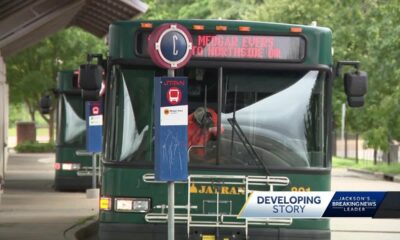Kaiser Health News
‘Until It Is Fixed’: Congress Ramps Up Action on Social Security Clawbacks
David Hilzenrath and Jodie Fleischer, Cox Media Group
Fri, 15 Dec 2023 10:00:00 +0000
The Senate Finance Committee is ramping up oversight of Social Security's overpayment problem and plans to meet with the agency every month “until it is fixed.”
The Social Security Administration assured lawmakers in the past that it had been addressed, but “what you all found in your reporting is that the problem hadn't been fixed,” Finance Committee Chair Ron Wyden (D-Ore.) said in an interview.
Wyden was referring to an ongoing investigation by KFF Health News and Cox Media Group television stations reporting how the agency has been issuing billions of dollars in overpayments — benefits it claims people never should have received — and then, sometimes years later, demanding they pay the money back.
“Millions of these individuals are walking an economic tightrope, balancing their food bill against the fuel bill, the fuel bill against the rent bill,” Wyden said. “And they have one of these overpayments and it just hits them like a wrecking ball.”
Meanwhile, congressional legislation that would raise asset limits for millions of Social Security recipients for the first time in decades has been gaining support.
The amounts the agency alleges people owe the government often total tens of thousands of dollars. The recipients include many of the nation's most vulnerable — people who are disabled and have minimal savings and incomes. Often the overpayments result from errors or lapses on the part of the Social Security Administration.
The agency has been sending overpayment notices to more than 2 million people a year, according to a government document KFF Health News and CMG obtained through a request under the Freedom of Information Act. The notices typically ask recipients to repay the government within 30 days. They also explain how to appeal or request that the government waive the debt.
The Finance Committee oversees Social Security. Wyden spoke with KFF Health News and CMG on Dec. 12 in his first interview with the news organizations since they began reporting on Social Security overpayments and clawbacks months ago. He was elaborating on a statement the committee posted last week.
“As the point person for getting this fixed, I'm committing to getting this turned around,” Wyden said.
“Your reporting has just been invaluable in terms of kind of opening up a lot of visibility and awareness to something that needs to be fixed.”
Wyden is co-sponsor of a Senate bill that would address one of the root causes of overpayments.
(WSB-TV, Atlanta)
In the Supplemental Security Income program, which provides monthly checks to people who have little or no income or assets and are over 65 or disabled, asset limits for beneficiaries haven't been adjusted since the 1980s. Those limits stand at $2,000 for individuals and $3,000 for couples.
The bill, spearheaded by Sens. Sherrod Brown (D-Ohio) and Bill Cassidy (R-La.), would raise the asset limits to $10,000 and $20,000, respectively, and adjust them for inflation in the future.
The bill has seven other co-sponsors in the Senate, including recent additions Lisa Murkowski (R-Alaska) and Sen. Patty Murray (D-Wash.), chair of the Appropriations Committee.
Chief executives of several major Wall Street firms, including Bank of America, Citigroup, Goldman Sachs, and Morgan Stanley, expressed support for the bill at a recent hearing, CNBC reported.
At a September news conference on Capitol Hill, a representative of JPMorgan Chase, which also backs the proposal, said the asset limits often prevent employees from participating in a 401(k) retirement plan to which the firm makes matching contributions.
A parallel bill in the House of Representatives has 10 lawmakers behind it.
“With growing bipartisan support in Congress and among the business and faith communities, we have a good chance to finally get this done,” Brown said in a statement for this article.
Legislation to raise the asset limits could be included in a government funding bill early next year, Brown spokesperson Kevin Donohoe said.
Wyden said he hopes the legislation becomes a campaign issue in the election year and that candidates are asked whether they support it.
The monthly meetings with the Social Security Administration will begin when a new commissioner is in place, Wyden said. President Joe Biden's nominee to head the agency, former Maryland Gov. Martin O'Malley (D), cleared the Finance Committee and is awaiting a confirmation vote by the full Senate.
In a recent hearing, O'Malley said accounts of people facing clawbacks were “heartbreaking” and promised to make the issue a priority.
Wyden said he expects the oversight meetings will include the top Republican on the Finance Committee, Sen. Mike Crapo of Idaho.
A spokesperson for Crapo, Mandi Critchfield, said he “is committed to addressing the overpayments issue, and looks forward to working with Senator Wyden to conduct proper oversight.”
One of the goals for those meetings, Wyden said, is to find out whether the agency can do more about overpayments using the legal powers it already has, including the authority to waive debts.
Wyden said he has discussed Social Security overpayments and clawbacks with officials at the White House.
In the interview, Wyden also addressed a recent report by KFF Health News and CMG that, according to the results of a public records request, the SSA has been sending overpayment notices to over a million more people a year than the agency's acting commissioner, Kilolo Kijakazi, disclosed at an October House hearing.
“When you have Social Security officials not telling the truth — and that's how I would characterize that report on the number of people for whom there was actually a problem — it really damages this incredibly important program's credibility,” Wyden said.
The news organizations obtained a copy of a piece of paper from which Kijakazi read aloud some numbers but not others at the October hearing.
SSA spokesperson Nicole Tiggemann said last week the agency could not confirm the accuracy of the counts — those Kijakazi presented at the hearing and those she left out.
Meanwhile, senior Democrats on the House Ways and Means Committee issued a statement this week calling for action on overpayments and clawbacks.
“Recent news reports have highlighted that the harm and unfairness Social Security beneficiaries experience after unknowingly being overpaid is more widespread than previously thought,” Reps. John B. Larson of Connecticut and Danny K. Davis of Illinois said.
Larson is the ranking Democrat on the Ways and Means Subcommittee on Social Security, and Davis is the ranking Democrat on the Subcommittee on Work and Welfare.
“The need for action is clear,” they said. “There must be a fundamental overhaul of Social Security's overpayment process – one that puts seniors and Americans with severe disabilities first.”
While the government is at fault for some overpayments, others result from beneficiaries failing to comply with requirements, intentionally or otherwise. That can include failing to keep the SSA updated about items such as earnings, assets, and in-kind support — for example, whether family members are giving the beneficiary food or a place to stay.
Systemic problems also contribute.
The SSA has relied on manual systems, and those are subject to human error.
Rules are complex and difficult for SSA staff and beneficiaries alike to follow.
People who receive federal disability benefits yet try to work can easily run afoul of restrictions not only on how much they are allowed to save but also on how much they are allowed to earn. For individuals who aren't blind, the monthly limit is $1,470.
The SSA relies heavily on beneficiaries to report changes in income, assets, and the like. For instance, the agency has been slow to implement systems that would automatically tap payroll data from outside sources.
Beneficiaries and advocates for Social Security recipients say the agency frequently loses information they submit. Getting through to humans at the agency can be extremely difficult, they say. Wait times are long, and calls get dropped.
O'Malley, the nominee for commissioner, recently told the Senate Finance Committee that the agency has a “customer service crisis.”
“The current wait times, backlogs, and delays are simply unacceptable,” O'Malley wrote.
The agency has cited staffing and funding. In the 2023 fiscal year, “we began to rebuild our workforce after ending FY 2022 with the lowest staffing level in 25 years,” the acting commissioner said in an October statement to a congressional subcommittee.
The agency closed field offices during the pandemic. That made it more difficult for beneficiaries to communicate with the SSA, and it caused problems to pile up.
The agency checks benefits retrospectively, which leaves it playing catch-up, researchers at the Urban Institute have said.
Regardless of who was originally at fault, by the time the SSA issues an overpayment notice, years can pass and the alleged overpayment total can balloon.
Under federal law, the agency must try to recover overpaid amounts, Kijakazi said in her October statement, and there is no statute of limitations. To collect debts, the SSA can reach back decades and across generations.
Do you have an experience with Social Security overpayments you'd like to share? Click here to contact our reporting team.
——————————
By: David Hilzenrath and Jodie Fleischer, Cox Media Group
Title: ‘Until It Is Fixed': Congress Ramps Up Action on Social Security Clawbacks
Sourced From: kffhealthnews.org/news/article/senator-ron-wyden-social-security-administration-monthly-meetings/
Published Date: Fri, 15 Dec 2023 10:00:00 +0000
Kaiser Health News
The Lure of Specialty Medicine Pulls Nurse Practitioners From Primary Care
Michelle Andrews
Fri, 17 May 2024 09:00:00 +0000
For many patients, seeing a nurse practitioner has become a routine part of primary care, in which these “NPs” often perform the same tasks that patients have relied on doctors for.
But NPs in specialty care? That's not routine, at least not yet. Increasingly, though, nurse practitioners and physician assistants are joining cardiology, dermatology, and other specialty practices, broadening their skills and increasing their income.
This development worries some people who track the health workforce, because current trends suggest primary care, which has counted on nurse practitioners to backstop physician shortages, soon might not be able to rely on them to the same extent.
“They're succumbing to the same challenges that we have with physicians,” said Atul Grover, executive director of the Research and Action Institute at the Association of American Medical Colleges. The rates NPs can command in a specialty practice “are quite a bit higher” than practice salaries in primary care, he said.
When nurse practitioner programs began to proliferate in the 1970s, “at first it looked great, producing all these nurse practitioners that go to work with primary care physicians,” said Yalda Jabbarpour, director of the American Academy of Family Physicians' Robert Graham Center for Policy Studies. “But now only 30% are going into primary care.”
Jabbarpour was referring to the 2024 primary care scorecard by the Milbank Memorial Fund, which found that from 2016 to 2021 the proportion of nurse practitioners who worked in primary care practices hovered between 32% and 34%, even though their numbers grew rapidly. The proportion of physician assistants, also known as physician associates, in primary care ranged from 27% to 30%, the study found.
Both nurse practitioners and physician assistants are advanced practice clinicians who, in addition to graduate degrees, must complete distinct education, training, and certification steps. NPs can practice without a doctor's supervision in more than two dozen states, while PAs have similar independence in only a handful of states.
About 88% of nurse practitioners are certified in an area of primary care, according to the American Association of Nurse Practitioners. But it is difficult to track exactly how many work in primary care or in specialty practices. Unlike physicians, they're generally not required to be endorsed by a national standard-setting body to practice in specialties like oncology or cardiology, for example. The AANP declined to answer questions about its annual workforce survey or the extent to which primary care NPs are moving toward specialties.
Though data tracking the change is sparse, specialty practices are adding these advanced practice clinicians at almost the same rate as primary care practices, according to frequently cited research published in 2018.
The clearest evidence of the shift: From 2008 to 2016, there was a 22% increase in the number of specialty practices that employed nurse practitioners and physician assistants, according to that study. The increase in the number of primary care practices that employed these professionals was 24%.
Once more, the most recent projections by the Association of American Medical Colleges predict a dearth of at least 20,200 primary care physicians by 2036. There will also be a shortfall of non-primary care specialists, including a deficiency of at least 10,100 surgical physicians and up to 25,000 physicians in other specialties.
When it comes to the actual work performed, the lines between primary and specialty care are often blurred, said Candice Chen, associate professor of health policy and management at George Washington University.
“You might be a nurse practitioner working in a gastroenterology clinic or cardiology clinic, but the scope of what you do is starting to overlap with primary care,” she said.
Nurse practitioners' salaries vary widely by location, type of facility, and experience. Still, according to data from health care recruiter AMN Healthcare Physician Solutions, formerly known as Merritt Hawkins, the total annual average starting compensation, including signing bonus, for nurse practitioners and physician assistants in specialty practice was $172,544 in the year that ended March 31, slightly higher than the $166,544 for those in primary care.
According to forecasts from the federal Bureau of Labor Statistics, nurse practitioner jobs will increase faster than jobs in almost any other occupation in the decade leading up to 2032, growing by 123,600 jobs or 45%. (Wind turbine service technician is the only other occupation projected to grow as fast.) The growth rate for physician assistants is also much faster than average, at 27%. There are more than twice as many nurse practitioners as physician assistants, however: 323,900 versus 148,000, in 2022.
To Grover, of the AAMC, numbers like this signal that there will probably be enough NPs, PAs, and physicians to meet primary care needs. At the same time, “expect more NPs and PAs to also flow out into other specialties,” he said.
When Pamela Ograbisz started working as a registered nurse 27 years ago, she worked in a cardiothoracic intensive care unit. After she became a family nurse practitioner a few years later, she found a job with a similar specialty practice, which trained her to take on a bigger role, first running their outpatient clinic, then working on the floor, and later in the intensive care unit.
If nurse practitioners want to specialize, often “the doctors mentor them just like they would with a physician residency,” said Ograbisz, now vice president of clinical operations at temporary placement recruiter LocumTenens.com.
If physician assistants want to specialize, they also can do so through mentoring, or they can receive “certificates of added qualifications” in 10 specialties to demonstrate their expertise. Most employers don't “encourage or require” these certificates, however, said Jennifer Orozco, chief medical officer at the American Academy of Physician Associates.
There are a number of training programs for family nurse practitioners who want to develop skills in other areas.
Raina Hoebelheinrich, 40, a family nurse practitioner at a regional medical center in Yankton, South Dakota, recently enrolled in a three-semester post-master's endocrinology training program at Mount Marty University. She lives on a farm in nearby northeastern Nebraska with her husband and five sons.
Hoebelheinrich's new skills could be helpful in her current hospital job, in which she sees a lot of patients with acute diabetes, or in a clinic setting like the one in Sioux Falls, South Dakota, where she is doing her clinical endocrinology training.
Lack of access to endocrinology care in rural areas is a real problem, and many people may travel hundreds of miles to see a specialist.
“There aren't a lot of options,” she said.
——————————
By: Michelle Andrews
Title: The Lure of Specialty Medicine Pulls Nurse Practitioners From Primary Care
Sourced From: kffhealthnews.org/news/article/nurse-practitioners-trend-primary-care-specialties/
Published Date: Fri, 17 May 2024 09:00:00 +0000
Did you miss our previous article…
https://www.biloxinewsevents.com/clean-needles-save-lives-in-some-states-they-might-not-be-legal/
Kaiser Health News
Clean Needles Save Lives. In Some States, They Might Not Be Legal.
Ed Mahon, Spotlight PA and Sarah Boden, WESA
Fri, 17 May 2024 09:00:00 +0000
Kim Botteicher hardly thinks of herself as a criminal.
On the main floor of a former Catholic church in Bolivar, Pennsylvania, Botteicher runs a flower shop and cafe.
In the former church's basement, she also operates a nonprofit organization focused on helping people caught up in the drug epidemic get back on their feet.
The nonprofit, FAVOR ~ Western PA, sits in a rural pocket of the Allegheny Mountains east of Pittsburgh. Her organization's home county of Westmoreland has seen roughly 100 or more drug overdose deaths each year for the past several years, the majority involving fentanyl.
Thousands more residents in the region have been touched by the scourge of addiction, which is where Botteicher comes in.
She helps people find housing, jobs, and health care, and works with families by running support groups and explaining that substance use disorder is a disease, not a moral failing.
But she has also talked publicly about how she has made sterile syringes available to people who use drugs.
“When that person comes in the door,” she said, “if they are covered with abscesses because they have been using needles that are dirty, or they've been sharing needles — maybe they've got hep C — we see that as, ‘OK, this is our first step.'”
Studies have identified public health benefits associated with syringe exchange services. The Centers for Disease Control and Prevention says these programs reduce HIV and hepatitis C infections, and that new users of the programs are more likely to enter drug treatment and more likely to stop using drugs than nonparticipants.
This harm-reduction strategy is supported by leading health groups, such as the American Medical Association, the World Health Organization, and the International AIDS Society.
But providing clean syringes could put Botteicher in legal danger. Under Pennsylvania law, it's a misdemeanor to distribute drug paraphernalia. The state's definition includes hypodermic syringes, needles, and other objects used for injecting banned drugs. Pennsylvania is one of 12 states that do not implicitly or explicitly authorize syringe services programs through statute or regulation, according to a 2023 analysis. A few of those states, but not Pennsylvania, either don't have a state drug paraphernalia law or don't include syringes in it.
Those working on the front lines of the opioid epidemic, like Botteicher, say a reexamination of Pennsylvania's law is long overdue.
There's an urgency to the issue as well: Billions of dollars have begun flowing into Pennsylvania and other states from legal settlements with companies over their role in the opioid epidemic, and syringe services are among the eligible interventions that could be supported by that money.
The opioid settlements reached between drug companies and distributors and a coalition of state attorneys general included a list of recommendations for spending the money. Expanding syringe services is listed as one of the core strategies.
But in Pennsylvania, where 5,158 people died from a drug overdose in 2022, the state's drug paraphernalia law stands in the way.
Concerns over Botteicher's work with syringe services recently led Westmoreland County officials to cancel an allocation of $150,000 in opioid settlement funds they had previously approved for her organization. County Commissioner Douglas Chew defended the decision by saying the county “is very risk averse.”
Botteicher said her organization had planned to use the money to hire additional recovery specialists, not on syringes. Supporters of syringe services point to the cancellation of funding as evidence of the need to change state law, especially given the recommendations of settlement documents.
“It's just a huge inconsistency,” said Zoe Soslow, who leads overdose prevention work in Pennsylvania for the public health organization Vital Strategies. “It's causing a lot of confusion.”
Though sterile syringes can be purchased from pharmacies without a prescription, handing out free ones to make drug use safer is generally considered illegal — or at least in a legal gray area — in most of the state. In Pennsylvania's two largest cities, Philadelphia and Pittsburgh, officials have used local health powers to provide legal protection to people who operate syringe services programs.
Even so, in Philadelphia, Mayor Cherelle Parker, who took office in January, has made it clear she opposes using opioid settlement money, or any city funds, to pay for the distribution of clean needles, The Philadelphia Inquirer has reported. Parker's position signals a major shift in that city's approach to the opioid epidemic.
On the other side of the state, opioid settlement funds have had a big effect for Prevention Point Pittsburgh, a harm reduction organization. Allegheny County reported spending or committing $325,000 in settlement money as of the end of last year to support the organization's work with sterile syringes and other supplies for safer drug use.
“It was absolutely incredible to not have to fundraise every single dollar for the supplies that go out,” said Prevention Point's executive director, Aaron Arnold. “It takes a lot of energy. It pulls away from actual delivery of services when you're constantly having to find out, ‘Do we have enough money to even purchase the supplies that we want to distribute?'”
In parts of Pennsylvania that lack these legal protections, people sometimes operate underground syringe programs.
The Pennsylvania law banning drug paraphernalia was never intended to apply to syringe services, according to Scott Burris, director of the Center for Public Health Law Research at Temple University. But there have not been court cases in Pennsylvania to clarify the issue, and the failure of the legislature to act creates a chilling effect, he said.
Carla Sofronski, executive director of the Pennsylvania Harm Reduction Network, said she was not aware of anyone having faced criminal charges for operating syringe services in the state, but she noted the threat hangs over people who do and that they are taking a “great risk.”
In 2016, the CDC flagged three Pennsylvania counties — Cambria, Crawford, and Luzerne — among 220 counties nationwide in an assessment of communities potentially vulnerable to the rapid spread of HIV and to new or continuing high rates of hepatitis C infections among people who inject drugs.
Kate Favata, a resident of Luzerne County, said she started using heroin in her late teens and wouldn't be alive today if it weren't for the support and community she found at a syringe services program in Philadelphia.
“It kind of just made me feel like I was in a safe space. And I don't really know if there was like a come-to-God moment or come-to-Jesus moment,” she said. “I just wanted better.”
Favata is now in long-term recovery and works for a medication-assisted treatment program.
At clinics in Cambria and Somerset Counties, Highlands Health provides free or low-cost medical care. Despite the legal risk, the organization has operated a syringe program for several years, while also testing patients for infectious diseases, distributing overdose reversal medication, and offering recovery options.
Rosalie Danchanko, Highlands Health's executive director, said she hopes opioid settlement money can eventually support her organization.
“Why shouldn't that wealth be spread around for all organizations that are working with people affected by the opioid problem?” she asked.
In February, legislation to legalize syringe services in Pennsylvania was approved by a committee and has moved forward. The administration of Gov. Josh Shapiro, a Democrat, supports the legislation. But it faces an uncertain future in the full legislature, in which Democrats have a narrow majority in the House and Republicans control the Senate.
One of the bill's lead sponsors, state Rep. Jim Struzzi, hasn't always supported syringe services. But the Republican from western Pennsylvania said that since his brother died from a drug overdose in 2014, he has come to better understand the nature of addiction.
In the committee vote, nearly all of Struzzi's Republican colleagues opposed the bill. State Rep. Paul Schemel said authorizing the “very instrumentality of abuse” crossed a line for him and “would be enabling an evil.”
After the vote, Struzzi said he wanted to build more bipartisan support. He noted that some of his own skepticism about the programs eased only after he visited Prevention Point Pittsburgh and saw how workers do more than just hand out syringes. These types of programs connect people to resources — overdose reversal medication, wound care, substance use treatment — that can save lives and lead to recovery.
“A lot of these people are … desperate. They're alone. They're afraid. And these programs bring them into someone who cares,” Struzzi said. “And that, to me, is a step in the right direction.”
At her nonprofit in western Pennsylvania, Botteicher is hoping lawmakers take action.
“If it's something that's going to help someone, then why is it illegal?” she said. “It just doesn't make any sense to me.”
This story was co-reported by WESA Public Radio and Spotlight PA, an independent, nonpartisan, and nonprofit newsroom producing investigative and public-service journalism that holds power to account and drives positive change in Pennsylvania.
KFF Health News is a national newsroom that produces in-depth journalism about health issues and is one of the core operating programs at KFF—an independent source of health policy research, polling, and journalism. Learn more about KFF.
USE OUR CONTENT
This story can be republished for free (details).
——————————
By: Ed Mahon, Spotlight PA and Sarah Boden, WESA
Title: Clean Needles Save Lives. In Some States, They Might Not Be Legal.
Sourced From: kffhealthnews.org/news/article/clean-needles-syringe-services-programs-legal-gray-area-risk-pennsylvania/
Published Date: Fri, 17 May 2024 09:00:00 +0000
Kaiser Health News
Watch: John Oliver Dishes on KFF Health News’ Opioid Settlements Series
Fri, 17 May 2024 09:00:00 +0000
Opioid manufacturers, distributors, and retailers are paying tens of billions of dollars in restitution to settle lawsuits related to their role in the nation's overdose epidemic. A recent broadcast of “Last Week Tonight With John Oliver” examined how that money is being spent by state and local governments across the United States.
The segment featured reporting from the KFF Health News series “Payback: Tracking the Opioid Settlement Cash.” You can learn more about the issue and read our collection of articles by Aneri Pattani here.
——————————
Title: Watch: John Oliver Dishes on KFF Health News' Opioid Settlements Series
Sourced From: kffhealthnews.org/news/article/watch-john-oliver-kff-health-news-payback-opioid-settlements-series/
Published Date: Fri, 17 May 2024 09:00:00 +0000
-
SuperTalk FM5 days ago
Martin Lawrence making 3 stops in Mississippi on comedy tour
-
Our Mississippi Home3 days ago
Beat the Heat with Mississippi’s Best Waterparks
-
Our Mississippi Home4 days ago
Charlie’s U-Pik: Opening Soon for the Summer Season
-
Mississippi News Video7 days ago
Local dentists offer free dental care in Amory
-
Kaiser Health News4 days ago
Medicaid ‘Unwinding’ Decried as Biased Against Disabled People
-
Mississippi News Video3 days ago
Jackson has a gang problem
-
SuperTalk FM13 hours ago
State auditor cracking down on Mississippians receiving unemployment benefits
-
Mississippi Today7 days ago
On this day in 1968




































